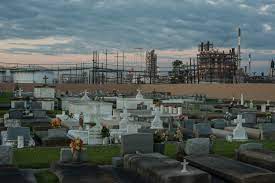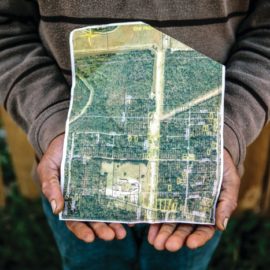
Cancer alley has been in the news since President Biden called is out as one of the worst areas in the country. Now others are taking up the call for action.
It was not a bus tour you’d usually find in the Louisiana guidebooks – but then again, the visitor from Arizona wasn’t here to take in the gumbo and brass bands. “Some communities should not have the burden of carrying the danger for the rest of the communities,” said U.S. Rep. Raul Grijalva, an Arizona Democrat who is pushing a bill in Congress to address environmental justice concerns. He spoke before boarding the bus about a week ago to drive past industrial plants in the area activists refer to as “Cancer Alley.” Grijalva’s visit was independent of the White House’s efforts on environmental justice. But it was another sign of the increased focus on the issue since President Joe Biden took office.
nola.com
Activists are happy with the attention but are worried that concrete action will not come as they do need help living in an areas filled with fumes and bad air.
The U.S. Environmental Protection Agency under Biden has put what some activists describe as an unprecedented amount of attention on environmental justice issues, including in Louisiana. The term refers broadly to a campaign on behalf of residents of low-income and Black communities that have disproportionately borne the brunt of pollution. But while people who have spent years advocating for these communities say they are appreciative of the efforts so far, they are also concerned it may not translate into enough concrete action. The Louisiana Chemical Association, meanwhile, has complained it was left out of discussions led by EPA head Michael Regan, who visited the state to highlight environmental justice in November, and argues plants have greatly reduced emissions in recent decades. The association also says that the industry’s economic contributions tend to be overlooked in such discussions.
Actions have been taken under the EPA since the Administrator came for a visit.
Actions involving Louisiana taken so far by the EPA under Regan, the first Black man to lead the agency, include an investigation into two state departments over the granting of plant permits. Regan also announced a series of steps related to air monitoring and other moves in Mossville in southwest Louisiana, St. John and St. James parishes, and the Gordon Plaza neighborhood in New Orleans. Beyond that, a proposed settlement of lawsuits against the EPA could further reduce toxic emissions at Denka Performance Elastomers and other plants in Louisiana. Still, community activists in the state say many of their concerns remain unaddressed. “If you want economic development, give us justice first,” said Joy Banner, co-founder of The Descendants Project. The group has been fighting plans for a huge grain elevator in the Wallace community in St. John the Baptist Parish, where Grijalva visited. “Economic development happens when you have a just system.”
The bus tour started at the Whitney Plantation whose lands are threatened by a grain elevator.
The recent bus tour began at the Whitney Plantation, set among sugarcane fields in St. John Parish, which focuses on telling the story of slavery’s brutal reality. Beyond Grijalva, a range of activists spoke at the plantation, including Banner and Russel Honoré, the retired lieutenant general who now leads the Green Army environmental group. The bus route traversed the Atlantic Alumina plant across the river from the plantation, much of the facility stained red from bauxite. Activists from the Louisiana Environmental Action Network say the site has been the state’s largest emitter of mercury, which is a health threat, particularly among fetuses and young children. The nearby Blind River has been under a fish-consumption advisory due to mercury levels. When it was previously known as Noranda Alumina, it was found to have been unknowingly emitting mercury into the air for years without a permit. The state Department of Environmental Quality later granted a company request for a permit allowing it to emit up to 1,500 pounds per year of mercury, but reduced it by 20% over time to 1,200 pounds per year. The DEQ cited the plant’s economic impact as well as its importance to the nation’s alumina supply – used to make aluminum – in granting the permit. Atlantic did not respond to a request for comment. Further along the road, there were also grain elevators, a refinery and, of particular note, the Denka Performance Elastomer plant.
Ah, yes, Denka. An anomaly among other chemical plants due to what it produces.
Headquartered in Japan, Denka produces chloroprene, which is used to make neoprene synthetic rubber and classified as likely capable of causing cancer. Elevated levels of it have been found in LaPlace. Air monitoring has been put in place around the site, including at the nearby Fifth Ward Elementary School in Reserve. Formerly owned by DuPont, it is the only plant in the nation that emits chloroprene. In April, the EPA said it was investigating the state DEQ and Department of Health over whether they discriminated against Black residents in permitting decisions related to Denka and two other planned facilities. Denka, which bought the facility in 2015, said it has “developed and has invested over $35 million in a voluntary emissions reduction program that reduced its chloroprene emissions by over 85% compared with 2014 facility emissions.” “In addition, DPE has voluntarily monitored chloroprene concentrations around its facility and in the area since 2016 and publicly provides data on ambient concentrations, which have shown a significant reduction,” spokesperson Jim Harris said.
Activists have worked for many years and have found a receptive ear in the EPA under Regan.
Activists have sought for years to draw further attention to such plants and their effect on nearby communities. They say their concerns have found a more receptive audience in Regan’s EPA. “It definitely feels to me like an unprecedented level of attention,” said Kimberly Terrell, a research scientist and director of community engagement with the Tulane Environmental Law Clinic. “The big question is: Does that translate to action, and then I would also add, do those actions directly reduce community exposure?” Terrell was co-author of a peer-reviewed study published in January drawing a link between cancer rates and carcinogenic air pollution in impoverished communities in Louisiana. The study included a range of factors and said it controlled for parish-level smoking and obesity rates. The Louisiana Chemical Association has disputed the findings, arguing that factors such as poor nutrition and a lack of preventative care in poor communities are to blame. The association did not respond to a request for comment.
The Bill that is being considered would require that the permitting process would use looking at all the cumulative air pollution not just the plant in question.
Key parts of the bill Grijalva was promoting include requiring the cumulative impact of pollution from multiple sources to be considered in permitting decisions, as well as strengthening the ability of communities to seek legal redress. Advocacy organizations such as Earthjustice support the legislation, both for its content and the way in which it was written. Grijalva’s tour was part of several trips he is making to gather local input. But while Earthjustice’s Raul Garcia praised the new attention around the issue, he said the Biden administration could be taking actions that do not require congressional approval, such as lowering standards for ozone and particulate matter or further regulations on coal ash. “It certainly is getting more attention,” said Garcia. “But I think that the results are not where they’re supposed to be yet.” The National Association of Manufacturers did not respond to a request for comment.
Last year Regan did not mince his words and that is what is hoped will lead to change.
As for Regan, he did not mince words when visiting Louisiana last year. During his tour of Mossville, a vanishing Black community near Lake Charles surrounded by industrial plants, he spoke near the fence of the Sasol chemical complex after viewing an air-monitoring unit that residents and activists said was inadequate. “I can tell you, being on the ground here, seeing it for myself, talking with the community members, it’s just startling that we got to this point,” Regan said. “And the question really is at this point, for all of us as federal, state and local government officials: What are we going to do moving forward?”
Let us hope the bill will be passed and signed and that more action will help those in Cancer Alley.



